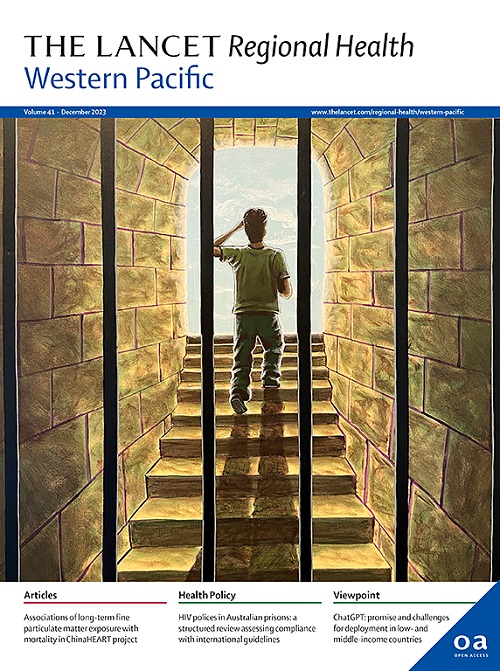社会经济劣势与早年和中年超重的多基因风险:一项为期 12 年的纵向人群队列研究
IF 7.6
1区 医学
Q1 HEALTH CARE SCIENCES & SERVICES
引用次数: 0
摘要
背景我们根据社会经济劣势和多基因风险对儿童和成人(他们的父母)平行队列中的体重指数进行了描述。我们研究了假设干预以减少儿童劣势是否可以减少青少年肥胖。方法在一个基于人口的队列(N = 5107)中,采用混合设计(调查和直接评估),24%-31% 有基因型数据:1607名儿童(50%为男性)从2-3岁到14-15岁每两年接受一次跟踪调查;2406名成年人(36%为男性)从平均年龄35-47岁接受跟踪调查。暴露因素包括体重指数的多基因风险得分,以及邻里和家庭层面的社会经济劣势,分为 "最差"(前两个特定组群的五分位数)、"一般 "或 "最差"(后两个五分位数)。我们按照多基因风险分层,探讨了估计体重指数和超重/肥胖风险在不利条件下的变化趋势。我们使用广义线性回归法估算了幼儿期生活在 "最不利/一般不利条件 "下的儿童相对于生活在 "最不利条件 "下的儿童在 14-15 岁时超重/肥胖的减少情况,并对混杂因素进行了调整。对多基因风险较高和较低的儿童分别进行了因果效应估计。研究结果 在多基因风险较高的参与者中,不利条件与超重/肥胖之间的正向趋势最为明显。在多基因风险较高的儿童(n = 805)中,假定目标试验结果表明,如果采取干预措施,将整个社区的不利条件从最不利降到最不不利,可将青少年超重/肥胖率降低 32%(风险比 (RR) 0.68,95% CI 0.50-0.92),如果采取干预措施,将家庭不利条件降低 42%(RR 0.58,95% CI 0.42-0.79)。如果将人群隔离为多基因风险较低的人群(7%-17%),以及不考虑多基因风险的整个人群(25%-39%),则积极效应较小。在人口层面上,尤其是对那些多基因风险较高的人群而言,解决不利条件可能会减少肥胖及相关的发病率、死亡率和成本。资金信息详见资金声明。本文章由计算机程序翻译,如有差异,请以英文原文为准。
Socioeconomic disadvantage and polygenic risk of overweight in early and mid-life: a longitudinal population cohort study spanning 12 years
Background
We describe BMI by socioeconomic disadvantage and by polygenic risk in parallel cohorts of children and adults (their parents). We examine whether hypothetically intervening to reduce childhood disadvantage could reduce adolescent obesity.
Methods
From a population-based cohort (N = 5107) with a mixed design (survey and direct assessment), 24–31% had genotype data: 1607 children (50% male) followed biennially from age 2–3 to 14–15; 2406 adults (36% male) followed from mean age 35–47 years. Exposures were polygenic risk score for BMI, and neighbourhood- and family-level socioeconomic disadvantage categorised as ‘most’ (top two cohort-specific quintiles), ‘average’, or ‘least’ disadvantage (bottom two quintiles). We explored trends in estimated BMI and risk of overweight/obesity by disadvantage, stratified by polygenic risk. We used generalised linear regression to estimate the reduction in overweight/obesity at 14–15 years in children living in ‘least/average disadvantage’ in early childhood relative to those in ‘most disadvantage’, adjusted for confounders. Causal effect estimates were obtained separately for children with higher and lower polygenic risk.
Findings
A positive trend between disadvantage and overweight/obesity was most apparent among participants with high polygenic risk. Among children with higher polygenic risk (n = 805), hypothetical target trial results imply that intervening to lessen population-wide neighbourhood disadvantage from most to least disadvantage could reduce adolescent overweight/obesity by 32% (risk ratio (RR) 0.68, 95% CI 0.50–0.92), or by 42% if intervening to lessen family disadvantage (RR 0.58, 95% CI 0.42–0.79). Positive effects were smaller when isolating the population to those with lower polygenic risk (7–17%), and for the whole population, regardless of polygenic risk (25–39%).
Interpretation
Children at higher polygenic risk of obesity suffer disproportionate BMI impacts of disadvantage. At the population-level, and especially for those with higher polygenic risk, tackling disadvantage could potentially reduce obesity and associated morbidity, mortality, and costs.
Funding
Australian National Health and Medical Research Council. Funding information is detailed in the funding statement.
求助全文
通过发布文献求助,成功后即可免费获取论文全文。
去求助
来源期刊

The Lancet Regional Health: Western Pacific
Medicine-Pediatrics, Perinatology and Child Health
CiteScore
8.80
自引率
2.80%
发文量
305
审稿时长
11 weeks
期刊介绍:
The Lancet Regional Health – Western Pacific, a gold open access journal, is an integral part of The Lancet's global initiative advocating for healthcare quality and access worldwide. It aims to advance clinical practice and health policy in the Western Pacific region, contributing to enhanced health outcomes. The journal publishes high-quality original research shedding light on clinical practice and health policy in the region. It also includes reviews, commentaries, and opinion pieces covering diverse regional health topics, such as infectious diseases, non-communicable diseases, child and adolescent health, maternal and reproductive health, aging health, mental health, the health workforce and systems, and health policy.
 求助内容:
求助内容: 应助结果提醒方式:
应助结果提醒方式:


